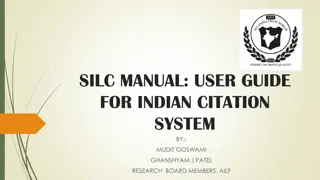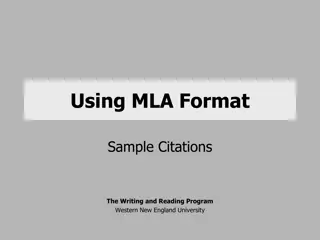MLA Citation and Documentation Guide
Explore the key elements of MLA (Modern Language Association) citation style, including its importance, core elements, new features in the 8th edition, and guidelines for documenting sources. Learn about in-text citations, Works Cited pages, author formatting, containers, and why proper documentation is crucial in academic writing.
Download Presentation

Please find below an Image/Link to download the presentation.
The content on the website is provided AS IS for your information and personal use only. It may not be sold, licensed, or shared on other websites without obtaining consent from the author.If you encounter any issues during the download, it is possible that the publisher has removed the file from their server.
You are allowed to download the files provided on this website for personal or commercial use, subject to the condition that they are used lawfully. All files are the property of their respective owners.
The content on the website is provided AS IS for your information and personal use only. It may not be sold, licensed, or shared on other websites without obtaining consent from the author.
E N D
Presentation Transcript
MLA 8th Edition Fred Meijer Center for Writing and Michigan Authors Lake Ontario Hall 120
What is MLA MLA stands for the Modern Language Association. It is the principal professional organization of language and literature scholars. As it focuses on language and literature, MLA is primarily the citation style of the humanities.
Whats new in MLA 8thedition MLA used to have many different ways of citing different sources, and many of those citations contained repeated information. The purpose of the MLA 8thedition was to streamline the citing process instead of someone asking how do I cite a [video/web document/article/etc.], a person just lists a work s main elements, which according to MLA are consistent across different media. Definitive Source: MLA Handbook, 8thEdition, 2016.
Why Document Sources in MLA Format? To give credit where credit is due: avoid plagiarism To establish your credibility To ensure consistency within a discipline: readers know what to expect To give readers access to the sources you cite
How Documentation Works In-text citations refer to a full citation on a Works Cited page Works Cited pages give readers bibliographic information to locate sources themselves
MLA (8thed) core elements 1.Author 2.Title of Source 3.Title of Container 4.Other Contributors 5.Version 6.Number 7.Publisher 8.Publication Date 9.Location
Author Previously, coauthors were only omitted if there were four or more authors for a source. However, this now happens with three authors or more where only the first author is given followed by et al. This is for in-text citations only. Works Cited: Burdick, Anne, et al. Digital_Humanities. MIT P, 2012. In Text Citation: (Burdick et al. 42)
Containers Containers are just a fancy way of saying whatever is holding your source whether that is a website, an anthology, a journal, a book, etc. Example: Baron, Naomi S. Redefining Reading: The Impact of Digital Communication Media. The Michigan Review, vol. 128, no.1, Jan. 2013, pp. 193-200.
Other contributors This means anyone else who aided in the creation of the source This is where you put translators and editors. Editors, translators, edited by, review of, etc. are no longer abbreviated. Example: Chartier, Roger. The Order of Books: Readers, Authors, and Libraries in Europe between the Fourteenth and Eighteenth Centuries. Translated by Lydia G. Cochrane, Stanford UP, 1994.
Number Number (or volume in some cases) is pretty straight forward, but it has changed from the previous edition. Instead of putting 64.1, for example, you d write out vol. 64, no. 1. Example: Baron, Naomi S. Redefining Reading: The Impact of Digital Communication Media. The Michigan Review, vol. 128, no.1, Jan. 2013, pp. 193-200.
Publisher Publisher simply means whatever company published the source being used. The main difference from before is that the city of publication is no longer given. Example: Lessig, Lawrence. Remix: Making Art and Commerce Thrive in the Hybrid Economy. Penguin Press, 2008.
Publication Date When a source does not have a date on it (like many online sources), it is now okay to just give the date accessed. n.d. is no longer used. If a fact from the source is found from some external place, then it is put in [square brackets]. Otherwise, the n.d. is omitted. Example: Hollmichel, Stefanie. The Reading Brain: Differences between Digital and Print. Atlantic, 25 Apr. 2015, somanybooksblog.com/2015/04/25/the-reading-brain- differences-between-digital-and-print/.
Location Location is just where to find the source whether that s a URL or a page number. Unlike previous MLA, we are back to including the URL For page numbers, in the works cited entry, p. or pp. comes before the page range. This however is not carried over into the in-text citation. Example: Baron, Naomi S. Redefining Reading: The Impact of Digital Communication Media. The Michigan Review, vol. 128, no.1, Jan. 2013, pp. 193-200.
Containers (cont.) Some entries will have a container one and a container two. An example of this would be a journal article that is in a journal and is found in a database. The journal is container one, and the database it s found in is container two. Container two comes AFTER the location in container one.
In-Text Parenthetical Citations Use them to: Quote directly Summarize material Paraphrase material Quick Tip: Plagiarism is using someone s words or ideas without giving the source proper credit.
Formatting An In-Text parenthetical Citation There are two common ways of writing an in-text citation: Integrate the author s name into the sentence itself Include the author s name in a parenthetical citation at the end of the passage in which you quote, summarize, or paraphrase the work. In Text Citation examples: In Run Rabbit Run, Rolo Tamasi argues that patience is not a virtue, but a curse (185). For some, patience is not a virtue, but a curse (Tamasi 185).
Fred Meijer Center for Writing & Michigan Authors Allendale, LOH 120: Monday-Thursday, 9am-6pm Friday, 9am-3pm Sunday, 2pm-6pm Allendale, Mary Idema Pew Library Knowledge Market, 1st floor: Sunday-Thursday, 6pm-11pm Online, Google Docs: Monday-Wednesday, 8pm-12am Downtown, Pew Campus, Steelcase Knowledge Market Monday-Thursday, 2pm-6pm Downtown, CHS Building, Grand Rapids, CHS 100 Monday & Thursday, 11am-2pm Schedule appointments at www.gvsu.edu/wc or just drop-in

 undefined
undefined


























